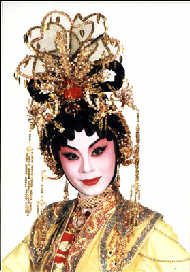 Cantonese Opera is popular in Guangdong, south of Guangxi Zhuang Autonomous Region and Hong Kong and Macao. In some places in Southeast Asia and Australia and America where there are overseas Chinese from Guangdong, Cantonese Opera has also become a fixture.
Cantonese Opera is popular in Guangdong, south of Guangxi Zhuang Autonomous Region and Hong Kong and Macao. In some places in Southeast Asia and Australia and America where there are overseas Chinese from Guangdong, Cantonese Opera has also become a fixture.
In Southeast Asia there are generations of artists, a fixed society, trade associations and traditional performance sites, such as "Qing Wei Xin" in Singapore, "Pu Chang Chun" in Kuala Lumpur, where many famous Cantonese Opera actors and actresses have been trained.
Cantonese opera originated in the Ming Dynasty (1368-1644), beginning under the reign of the emperor Jiajing (1522-64) and developed through the centuries. Formerly, the music was almost identical to older and more established operatic types, but since the beginning of this century it has become a blend of conventional patterns and fragments from Cantonese folk melodies, popular songs, modern Cantonese instrumental compositions and even Western tunes.
Cantonese Opera music consists of innumerable melodies and tunes. In Cantonese opera the music isn't the most important part - the lyrics are. In Cantonese opera the writers put words into this pool of melodies and tunes. One song may contain many melodies, and it is up to the singer to add his or her own personal variation and style to the melody when they sing it. Traditional Chinese instruments such as theerhu,butterfly harp,pipa, flute, and percussion make up the orchestra. The percussion alone consists of many different drums and cymbals. The percussion is responsible for the overall rhythm and pace of the music, while theerhuleads the orchestra. Now, Cantonese opera has incorporated many western instruments such as the cello, saxophone, and even the violin that is often used in place of theerhu.
There are two types of Cantonese Opera plays. One is called "Mun," and the other is called, "Mo."
Momeans martial arts. Characters inMoplays are usually generals or warriors.Moplays are action-packed and intricately choreographed, often using weapons. The costumes for Mo plays are very complicated (and heavy).
Munmeans intellectual, polite, and cultured. These are the plays whose characters are either scholars, royalty. Mun plays tend to be dramatic and the movements are soft and slow. Instead of using weapons, performers show of their abilities in water sleeves work (see terms below). This type of play focuses more on facial expression, tone of voice, and meaning behind the movements.
Cantonese opera acting is not the same as acting in movies or on TV. Many emotions have certain facial expressions and body gestures that go along with them. Performers also have to be careful not to ruin their makeup or hair with histrionic expressions.
The background stories are based on a wide range of subjects, including romantic encounters, historical events, fictionalized episodes, ghost stores, patriotic happenings, moral teachings, famous classics, pseudo-religious tales and heroic epics. Beyond entertainment, the operas educate people about many facets and levels of the Chinese language, belief system, society, arts and history. Cantonese opera costumes provide socio-historical contexts and are designed for symbolic and aesthetic effect.
